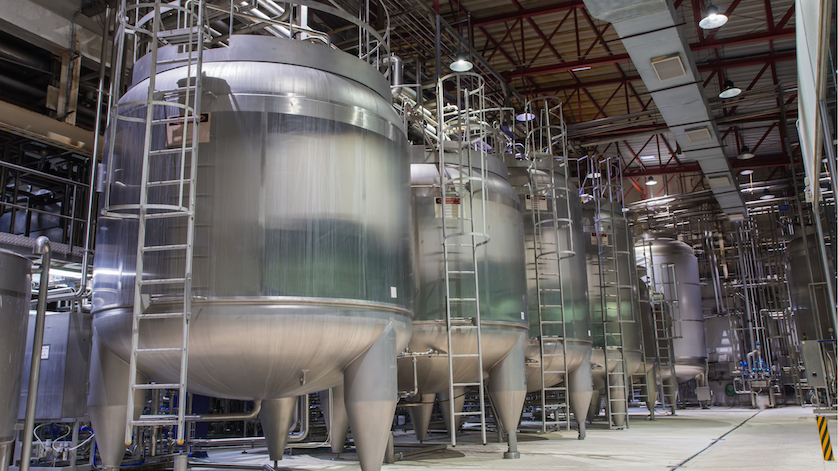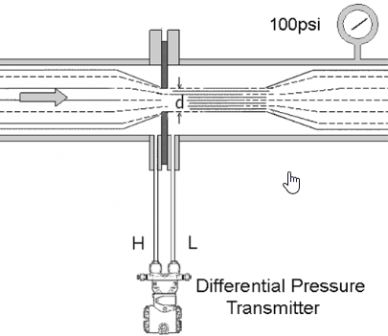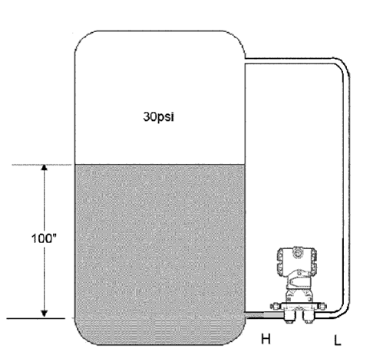
Differential pressure transmitters are designed to measure pressure before and after the fluid encounters an interruption, such as a filter or pump. However, this pressure instrument can also be used to measure liquid levels.
The market offers several methods for measuring and monitoring liquid levels. For closed vessels, operators commonly choose a differential pressure transmitter. This is a proven technique, especially when the measuring instrument should not be immersed in the media, such as for tanks that have a grinder or hold aggressive substances. However, if the application requires high accuracy, this method of level measurement soon comes up against its limits.
Before making the case for using two interconnected process transmitters rather than other configurations or instruments, let’s take a look at what a differential pressure transmitter is and how this pressure instrument measures liquid levels.

Figure 1: In a pipe, a differential pressure transmitter measures pressure drop (d) from the higher point (H) to the lower point (L).
What Differential Pressure Transmitters Do
A differential pressure transmitter measures and calculates the difference between two points of pressures, and sends that information via a signal to a programmable logic computer (PLC).
These sensors were originally designed for use in pipes to measure pressure before and after the fluid encounters a filter, pump, or another interruption in flow. Standard differential pressure transmitters come with two process connections arranged side by side to measure the drop in pressure (d) between the higher and lower points (H and L, respectively, in Figure 1). Classic differential pressure transmitters can also measure flow rates.
It wasn’t long before people realized that differential pressure measurements could be used to determine liquid level as well.
Measuring Level with a Differential Pressure Transmitter: Advantages and Challenges

Figure 2: Differential pressure transmitter configured to measure level inside a tank.
A differential pressure transmitter calculates level by measuring the differential pressure between the liquid and the gaseous phases of the fluid inside a closed tank. For precise calculations, important factors include:
- Geometry of the tank (horizontal or vertical, shapes of various lids and bottoms, etc.)
- Specific density of the medium
- Hydrostatic pressure
The distance between points H and L in a tank is necessarily much longer than in a pipeline, necessitating the use of tubing to bridge that distance (Figure 2). But not just any size of tube will do. For accurate measurements, these small pipes – capillaries, really – have to be so thin and limited in volume that they transmit media without any changes in pressure.
However, using capillaries creates its own set of challenges. Within an enclosed system, the pressure of a gas is directly proportional to its temperature. This is Gay-Lussac’s Law. In larger pipes, an increase in temperature/pressure won’t have much effect on differential pressure readings. But within the confines of a capillary, any changes in temperature and, thus, pressure are magnified. Measurement solutions with this kind of connection to the measuring points are sensitive to temperature. In the worst case scenario, severe fluctuations could result in false measured values.
Read Part 2 of this blog: The Advantage of Using Two Interconnected Process Transmitters for Differential Pressure Measurement.


I have a tank with 20bar steam pressure can I measure water level in the same tank with differential pressure transmitter note that water level from 0 to 3.5kpa and the steam pressure is changing from 0 to 20bar, when there’s no pressure in the tank it works well and the reading changing from 0 to -3.5kpa put when pressure inside the tank increase the reading changed to 6kpa or 15kpa
For a pressurized tank you would need to use a differential pressure measurement device to get an accurate level of a sealed or pressurized tank. One leg of the differential device should only be measuring the steam pressure (for example at the very top of the tank) and the other leg should be measuring both the liquid level and the steam pressure (for example at the very bottom of the tank). With this configuration, the differential transmitter will essentially remove the steam pressure from the reading if the device is set up to subtract the steam pressure only side from the steam and liquid level side.
Exactly I did what you said but my question is can DPT sence with level changing which change from 0 to 3.5kpa under steam pressure 2000kpa or level will not be calculated as error percentage
The exact error percentage will depend on the range selected on the DPT-20, but for the largest selectable measuring range +/-16BAR (maximum working pressure of 160Bar), you should be able to read with an accuracy of +/- 1.04kPa. If you need better accuracy you could select a smaller measuring range.
IS THERE ANY UP STREAM AND DOWN STREAM RATIO IS REQUIRED AT THE TIME OF DP TRANSMITTER.
There is not a ratio of upstream to downstream pressure required for our DPT-20 transmitter. Both sides can see the maximum working pressure for the device. Both sides can also briefly handle 1.5times the maximum working pressure for brief periods of time.